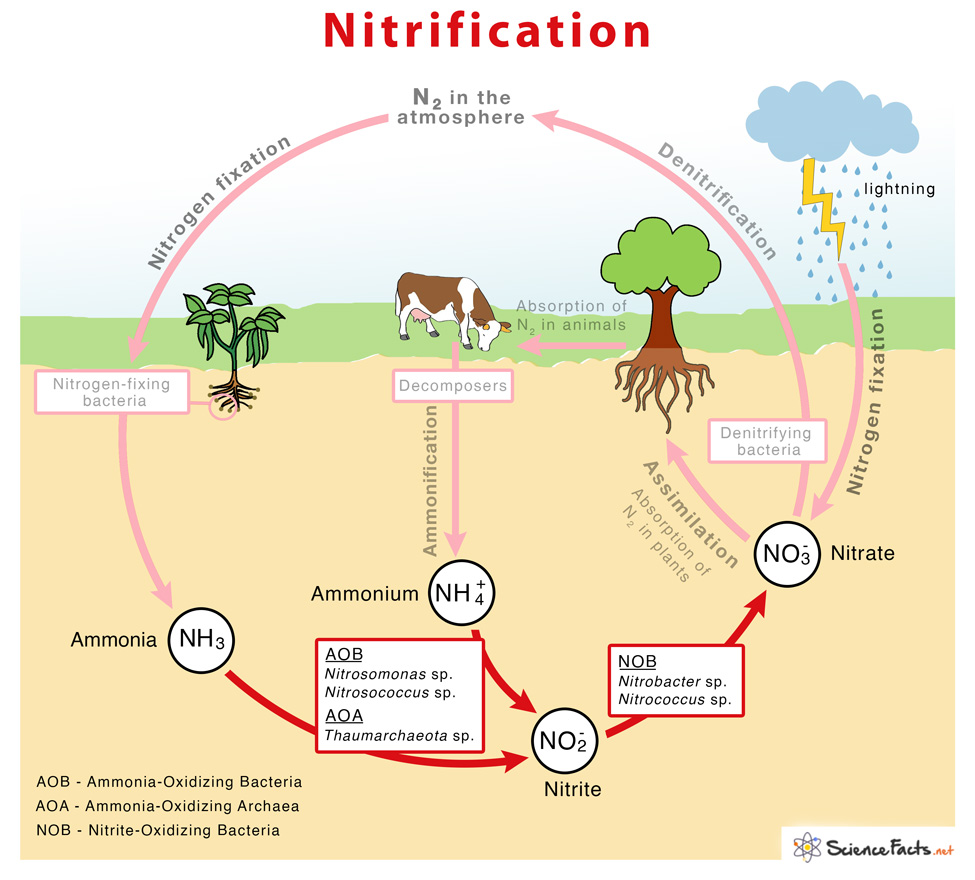Nitrification
Nitrification is an essential step in the nitrogen cycle of soil, water, and wastewater treatments. It involves the biological oxidation of ammonia (NH3) or ammonium (NH4+) to nitrite (NO2–) and then from nitrite (NO2–) to nitrate (NO3–). Thus it involves two steps, as shown below.
Each step is catalyzed by functionally distinct groups of microbes known as nitrifiers. They grow on organic carbon by fixing carbon dioxide through Calvin Cycle.
Process of Nitrification
The two steps of nitrification are described below:
Step 1: Conversion of Ammonia to Nitrite
NH3 + O2 → NO2– + 3H+ + 2e–
It is primarily carried out by two distinct groups of ammonia-oxidizing microbes commonly found in aerobic environments.
One is the ammonia-oxidizing bacteria (AOB) present in the soil. Nitrosomonas is the most commonly identified genus associated with this step. However, other genera such as Nitrosococcus and Nitrosospira also perform ammonia oxidation. They grow by producing ATP from ammonia oxidation and using that energy to fix carbon dioxide by the Calvin Cycle. This step of nitrification is the rate-limiting step.
The second group of microbes that carry out the oxidation of ammonia is the ammonia-oxidizing archaea (AOA), such as Thaumarchaeota. AOA is abundant in soil and marine environments fixing carbon dioxide by the 3-hydroxypropionate/4-hydroxybutyrate pathway instead of the Calvin Cycle.
Apart from AOB and AOA, the third group of bacteria of the members of the phylum Planctomycetes such as Brocadia anammoxidans, also perform ammonia oxidation. The equation below shows that they oxidize ammonium using nitrite instead of oxygen, producing N2 instead of nitrite by the acetyl-CoA pathway.
NO2– + NH4+ → N2 + 2H2O
This process is strictly anaerobic, and the process is known as anaerobic ammonia oxidation or anammox.
Step 2: Conversion of Nitrite to Nitrate
NO2– + H2O → NO3– + 2H+ +2e–
It is carried out by nitrite-oxidizing bacteria (NOB). Nitrobacter is the most commonly identified genus associated with this step. However, other genera such as Nitrospina, Nitrococcus, and Nitrospira also perform nitrate oxidation. NOBs similar to AOBs use nitrite to fix carbon dioxide by the Calvin Cycle.
Nitrification has some essential ecological significance. The significance is briefly described below.
Importance of Nitrification
Adding nitrogen as ammonium ions by nitrogen-fixing bacteria is known to enrich the soil, increasing its productivity. Also, the addition of nitrogen as soil fertilizers increases soil productivity. In contrast, nitrification uses up the ammonia fixed during nitrogen fixation and through fertilizer application, thus decreasing its productivity.
Nitrification inhibitors are often applied to slow down this conversion and increase the amount of N available to the plants. Thus, nitrification:
- Determine the availability of nitrogenous fertilizer in the agricultural field
- Determine the form of nitrogen available for primary production in the surface layer of marine water bodies
- Involves in the removal of excess nitrogen in the form of ammonia from the wastewater treatment plants
-
References
Article was last reviewed on Friday, February 17, 2023




